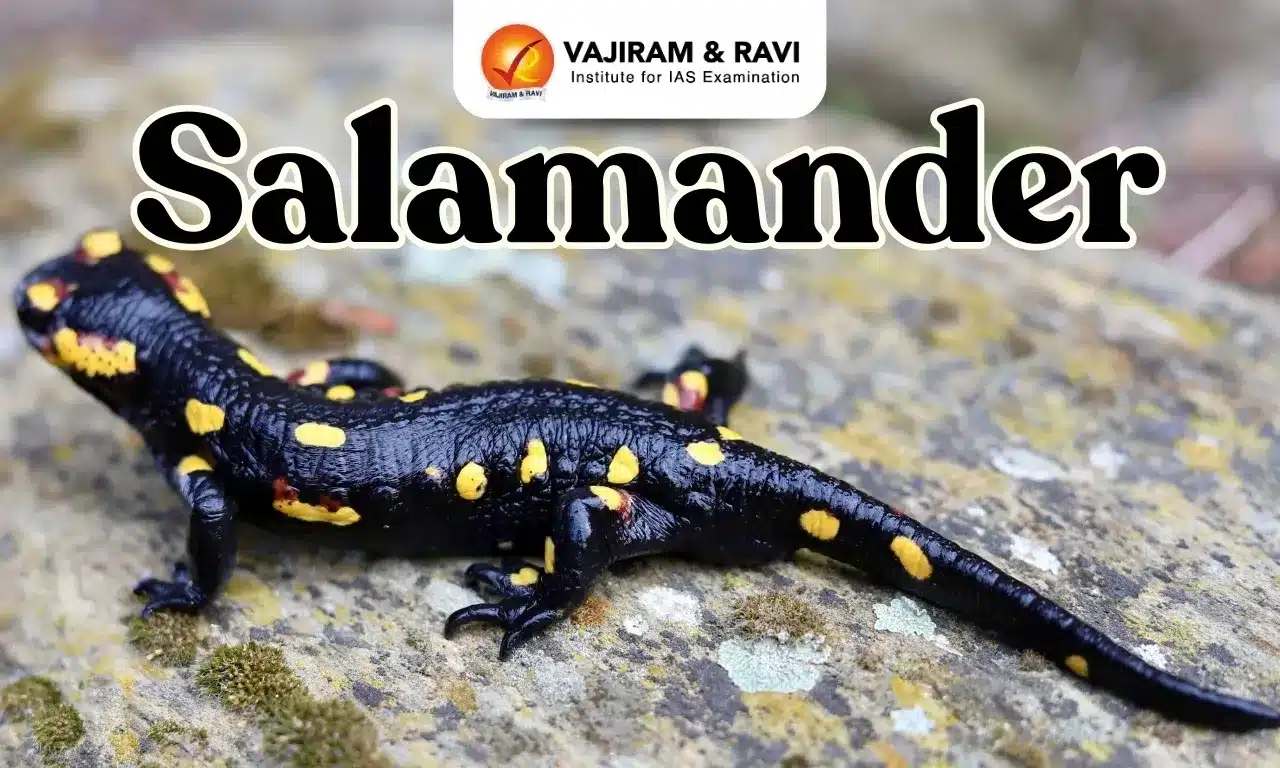Salamander Latest News
Researchers discovered that wandering salamanders can rapidly fill, trap, and drain the blood in their toe tips to optimise attachment, detachment and general locomotion through their arboreal environment.
About Salamander
- It is an amphibian with a slender body and a long tail.
- Features of Salamander
- Size: Their size varies with different species, ranging from 2.5 cm to 20 cm. The largest salamander in the world is the Chinese Giant Salamander, which can grow up to a length of 5 feet.
- Most salamanders look like a cross between a lizard and a frog. They have moist, smooth skin, like frogs, and long tails, like lizards.
- Habitat of Salamander: They live in or near water or find shelter on moist ground and are typically found in brooks, creeks, ponds, and other moist locations, such as under rocks.
- Distribution of Salamander: They are mainly found in North America, Europe, Asia, the northern parts of South America, and North Africa.
- Regeneration of Salamander: They are capable of regenerating lost limbs within a few weeks, including tails and toes, allowing them to survive attacks from predators.
- They are nocturnal and cold-blooded species and their temperature changes with their habitat.
- Some salamander species can be poisonous, and some even have teeth.
Highlights of the research
- The researchers uncovered that wandering salamanders can finely control and regulate blood flow to each side of their toe tips.
- This allows them to adjust pressure asymmetrically, improving grip on irregular surfaces like tree bark.
- The blood rushing in before “toe off” appears to help salamanders detach rather than attach. By slightly inflating the toe tip, the salamanders reduce the surface area in contact with the surface they are on, minimising the energy required to let go.
- Significance: Insights into salamander toe mechanics could ultimately inform the development of adhesives, prosthetics, and even robotic appendages.
Salamander FAQs
Q1: What is another name for a salamander?
Ans: Olm, axolotl, spring lizard, water dog, mud puppy, hellbender, triton, and Congo eel.
Q2: Why are salamanders special?
Ans: Salamanders control pests by eating insects like mosquitos and by becoming food for larger animals. Their moist, permeable skin makes salamanders vulnerable to drought and toxic substances.
Q3: What is the ecological role of the salamander?
Ans: They regulate food webs and contribute to ecosystem resilience-resistance (= stability).
Source: TH
Last updated on December, 2025
→ Check out the latest UPSC Syllabus 2026 here.
→ Join Vajiram & Ravi’s Interview Guidance Programme for expert help to crack your final UPSC stage.
→ UPSC Mains Result 2025 is now out.
→ UPSC Notification 2026 is scheduled to be released on January 14, 2026.
→ UPSC Calendar 2026 is released on 15th May, 2025.
→ The UPSC Vacancy 2025 were released 1129, out of which 979 were for UPSC CSE and remaining 150 are for UPSC IFoS.
→ UPSC Prelims 2026 will be conducted on 24th May, 2026 & UPSC Mains 2026 will be conducted on 21st August 2026.
→ The UPSC Selection Process is of 3 stages-Prelims, Mains and Interview.
→ UPSC Result 2024 is released with latest UPSC Marksheet 2024. Check Now!
→ UPSC Prelims Result 2025 is out now for the CSE held on 25 May 2025.
→ UPSC Toppers List 2024 is released now. Shakti Dubey is UPSC AIR 1 2024 Topper.
→ UPSC Prelims Question Paper 2025 and Unofficial Prelims Answer Key 2025 are available now.
→ UPSC Mains Question Paper 2025 is out for Essay, GS 1, 2, 3 & GS 4.
→ UPSC Mains Indian Language Question Paper 2025 is now out.
→ UPSC Mains Optional Question Paper 2025 is now out.
→ Also check Best IAS Coaching in Delhi

















